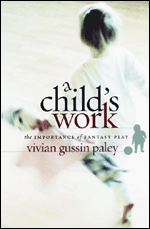

|
Big "A" and Little "a"
An excerpt from Child's Work: The Importance of Fantasy Play
by Vivian Gussin Paley
When did first grade lose its status in the United States as the beginning of formal learning? That was a time when kindergarten children were called the "little ones" by the other teachers who came by to watch them play. Even the older children recognized the difference between pretend and real schoolchildren. "Kindergarten babies, first-grade ladies" was the refrain heard on the playground, and there was some truth in the ancient tease.
Kindergartners were expected to be somewhat "babyish," and "immature" was a stage of growth and not an accusation when I began to teach. Yet, compared to nursery school children, the kindergarten girls and boys had entered the graduate program in fantasy play. The themes were lengthened and deepened and their conversations were more complex and analytical.

First-grade teachers approached their tasks slowly, knowing that their newest students still had one foot in fantasy play. "This is a big A," the teachers announced on the first day. "We'll do big A's for a while and then be ready for little a's." This was how the alphabet was introduced in first grade when I was a child and even when I began teaching in New Orleans in the fifties. The goal was seldom to teach the letter A; all the children knew their A's plus a few other letters as well. Some had begun to read on their own. But the display of the alphabet was the opening salvo of real school, where reading and writing would begin in earnest.
First-grade teachers were among the strongest advocates for the sanctity of kindergarten, warning us to stay in our own territory and not invade theirs. "Don't get into lowercase," they told us. There would be dire consequences, such as bad handwriting, nervousness, stuttering, and, in general, the self-defeating attitudes that often accompany the too-early introduction of formal lessons.
Behind kindergarteners' attempts to write or read there were attributes, we were told, that we couldn't see and might misjudge, eye-hand coordination and aural discrimination being a few examples. And there were characteristics of kindergartners that were plain enough for everyone to see: restlessness, impulsivity, timidity, and a general state of dreaminess. The children themselves continually reminded us that play was still their most usable context. It was not the monsters they invented that frightened them in kindergarten; it was being told to sit still and pay attention for long periods of time.
Short attention spans were not yet considered a deficit in my schools in Great Neck, N.Y., and Chicago in the sixties and seventies. We saw that the children's concentration was intense when they played and we filled the other times with playful rhyming games, songs, and poetry, to which we added picture books and fairy tales. The children's own chants and shouts rang out as they ran, climbed, jumped, pushed, pulled, and rearranged their environment, all in the name of fantasy play. Restlessness, impulsivity, and timidness faded in the quest for a dramatic role, and daydreams awakened into social play and big arcs of paint.
There were faculty discussions in the sixties about the "new" superhero play. Did the growing access to television change the children's behavior? Now that Superman and Batman could be seen in action, was play becoming too aggressive? It was clear that the boys felt compelled to copy the look and sounds of every new superhero that appeared on television and in the toy stores, but the play itself was little different from the cowboy and army play of earlier generations and could be tolerated. Soon Barbie would arrive and the kindergarten girls did not take long to remake her into a mother, sister, or princess. In other words, little seemed changed in terms of kindergarten play and the opportunities it provided for expansive social interaction, innovative thinking, and endless subjects for conversation.
What we may have overlooked was the fact that young children were spending far more time watching television than ever they had listening to the radio. None of us imagined that children at home would voluntarily limit their own playing in order to watch television. We still took play for granted and talked about nearly everything else except its literary or philosophical potential. It was as if, in a discussion of library books, we spoke about the paper, the print, the bindings, and the cover, and ignored the stories that compelled the authors to write the books. Nonetheless, we found enough to admire in play to keep it center stage in classroom life.
Then, midway through the eighties and nineties, a new sentiment began to be heard. With the growth of nursery schools and childcare centers came the notion that there was too much play. Since children were entering school at a younger age, wouldn't they have had enough play before kindergarten? The need for play, in other words, was considered to be a factor of the number of early years spent in school. Furthermore, these early years were designated as the optimum time to introduce the shapes and sounds of letters rather than the shapes and sounds of characters in a story.
The principles of child development were being rewritten, unaccompanied by a huge outcry of disbelief. One began to hear the word "boredom" attached to play, probably for the first time in human history. It was an odd concept to tag on to the single activity children loved best, but there was a growing nervousness about what was going on (or not going on) in kindergarten. The "academic kindergarten" was offered as the antidote to boredom and, further confusing our logic and commonsense, children labeled "at risk," who often had less opportunity for play and talk at home, were allowed less time for these activities in school as well.
At educational conferences in the nineties, kindergarten teachers continued to defend play, even as they had to allow more and more paperwork to clutter the tables and walls. Some teachers tried to recapture the certainties of the past by collecting antique block sets and doll-corner cribs, ancient dolls, and little wooden cars and trains, resisting anything that came in a catalogue. But we overlooked the real villain in our midst. It turned out to be not so much the "academics" we were adding but the time we subtracted from the children's fantasy play that would begin to make the difference.
Having not listened carefully enough to their play, we did not realize how much time was needed by children in order to create the scenery and develop the skills for their ever-changing dramas. We removed the element - time - that enabled play to be effective, then blamed the children when their play skills did not meet our expectations.
Although we feared the influence of television, we were cutting down on the one activity that counteracts the mindlessness of cartoons. We blamed television for making children restless and distracted, then substituted an academic solution that compounded restlessness and fatigue. The children may have been the only ones capable of making sense of the confusion, and they did so whenever the schedule was cleared so they could play.
The misplaced academics of kindergarten affected the first grade as well. When kindergarten was the place for pretending school, first-grade teachers could take their time beginning formal lessons. It was always assumed that there would be ordinary children, without exceptional handicaps, who benefited from extra time to grow into academic areas. We called it maturation, and it was an important concept when we talked about children. "Is it maturation or personality?," we would ask when a child did not adapt to our activities. We were more inclined back then to look for fault lines in the curriculum than in the child.
We now have reversed the order of events. It is generally believed that the earlier we begin to train a child in reading and writing skills, the better off everyone will be. In many classrooms, the "pretend writing" of fours and fives looks real enough to begin keeping progress records. By the nineties a "chicken-and-egg" dilemma became apparent to me. Since the earlier we begin academics, the more problems are revealed, were the problems there waiting to be discovered or does the premature introduction of lessons cause the problems?
This conundrum does not exist in the abstract. Expectations for incoming first-graders are quite precise, and the tension begins even before the teacher and student meet. The potential for surprise is largely gone. We no longer wonder "Who are you?" but instead decide quickly "What can we do to fix you?"
Copyright - reprint with permission only (see below)
Vivian Paley, a kindergarten and nursery school teacher for thirty-seven years, primarily at the University of Chicago Laboratory Schools, has received numerous awards and accolades, including a MacArthur Award and most recently the John Dewey Society's Outstanding Achievement Award. She is the author of eleven books.
For more information about the book, Child's Work, and details on purchasing it from bookstores or online - please go to this web page: University Press
|
Copyright notice: Excerpt from pages 42-47 of A Child's Work: The Importance of Fantasy Play, by Vivian Gussin Paley, published by the University of Chicago Press. ©2004 by the University of Chicago. All rights reserved. This text may be used and shared in accordance with the fair-use provisions of U.S. copyright law, and it may be archived and redistributed in electronic form, provided that this entire notice, including copyright information, is carried and provided that the University of Chicago Press is notified and no fee is charged for access. Archiving, redistribution, or republication of this text on other terms, in any medium, requires the consent of the University of Chicago Press. |
 |
Back to BestHomeschooling Home |
Copyright 2004 BestHomeschooling.org. All rights reserved.
Please feel free to link to this site, BestHomeschooling. org, but do not
copy material and/or reproduce or distribute it in any way without
permission. Authors of articles retain the rights to their own
articles which may not be reproduced without their permission. |